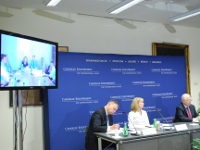Registration
You will receive an email confirming your registration.
This month marks the one-year anniversary of the U.S.–Russia Bilateral Presidential Commission (BPC), launched by Presidents Obama and Medvedev in their July 2009 summit meeting. The commission’s goal of advancing cooperation on a wide range of issues, including business development and economic relations, fits in with President Medvedev’s efforts to put the modernization of Russia’s economy at the center of his agenda.
The Carnegie Endowment for International Peace in Washington and the Carnegie Moscow Center, in partnership with the U.S.-Russia Business Council, brought together officials and experts in Washington and Moscow to discuss the recent accomplishments of the BPC Working Group on Business Development and Economic Relations. U.S. Department of Commerce’s Deputy Undersecretary for International Trade Michelle O’Neill and Trevor Gunn of Medtronic, Inc, joined the discussion from Washington, and Elena Vladimirovna Danilova, of the Russian Ministry of Economic Development, as well as Sergei Borisov of the Russian business group OPORA and Carnegie’s Sergei Aleksashenko, joined from Moscow. Carnegie’s Ambassador James Collins and Sam Greene co-hosted the event from Washington and Moscow, respectively.
The Commission’s Accomplishments
Both Ms. Danilova and Undersecretary O’Neill commented on their work as part of the BPC’s Business Development and Economic Relations working group. The Working Group is focused on issues related to economic efficiency, energy efficiency, resource efficiency, and modernization of the Russian economy, Danilova explained. Specifically, its chief goal is to make the investment climate more hospitable for foreign investors and to attract foreign investment. O’Neill described two broad categories central to the efforts of the working group:
- Eliminating existing barriers to trade and investment
- Identifying new avenues for commercial cooperation
O’Neill and Danilova described some of the working group’s accomplishments and proposed projects:
- Recent legislation liberalizing the rules for foreign specialists who work in Russia, which represented an early but significant accomplishment for the working group as it was one of the top business priorities.
- Bilateral memoranda of understanding in areas such as patent protection, investment policy, and small-business development, which are a way to stimulate cooperation in new economic arenas and signal the intent on both sides to work together on issues of shared significance.
- Russian business deals with well-known U.S. companies, such as John Deere, Boeing, International Paper, Chevron, and Cisco were more than investment projects, O’Neill and Danilova explained. They also represent a win-win scenario that benefited both the U.S. economy and U.S. businesses and the Russian economy and Russian businesses.
- Trade missions provide an opportunity to generate greater awareness among government officials from both countries of the potential for economic cooperation and investment. Examples include a proposal currently under consideration for a visit of Russian government experts to U.S. companies engaged in high-tech sectors--such as health care, telecom, and energy efficiency. There is also an industry-specific trade mission scheduled for October that will focus on aerospace suppliers, including Russian Technologies and Boeing.
- Contributions to the negotiations of Russia’s accession to the WTO were also a part of the working group’s efforts to promote bilateral economic cooperation. Russia’s accession to the WTO would create more favorable conditions, more transparency, and more predictable legal conditions for both investors and trading companies.
The Role of Small- and Medium-Size Enterprises
Borisov underlined the increasing role of small- and medium-size enterprises (SMEs) in the modernization of the Russian economy. Given the relative youth of the modern Russian economy and that it inherited a centrally planned economy from the Soviet Union, Russia tends to focus on large corporations, while underestimating the role of SMEs in the economic development.
- In the United States, SMEs contribute up to 60 per cent of GDP, while in Russia this figure is three times smaller.
- Similarly, less than twenty percent of the Russian labor force is engaged in the SME sector.
For this reason, the Working Group has launched a subgroup on SMEs with the task of restructuring the SME sector and ensuring that it is dominated by high-tech, cutting-edge, and innovative companies, Borisov explained.
Gunn, whose business has been working in Russia for more than two decades and has one hundred employees in Russia, presented examples that could help create an environment for sustainable modernization. One such example is the Skolkovo project, which is intended to establish a hi-tech research hub in Russia. Although there are many hurdles to doing business in Russia, Gunn stated that there are emerging long-term advanced technology possibilities in Russia.
Potential for Further Cooperation
Speakers in both Washington and Moscow agreed it was surprising that Russia was only America’s 32nd largest export market in 2009, given that Russia is one of the ten largest economies in the world and considered one of the four largest and most dynamic emerging markets in the world. To explain this paradox, Aleksashenko noted Russia’s manufacturing capacity limits, high transportation costs, somewhat high labor costs, and, above all, poor investment climate and lack of rule of law. He argued that Russia has to improve its investment climate for investors from all countries, including itself.
Trade is not the best platform to increase economic cooperation between Russia and the United States, Aleksashenko contended. Instead, technological cooperation can lead to mutual investing which is, according to Aleksashenko, “the area where Russia definitely has a certain competitive advantage vis-à-vis other countries, emerging countries, or even developed countries.”
“We believe that the deliverables of our work should not be limited to various memorandums and documents and statements,” Danilova concluded. “It should lead to practical results on the ground. Our progress will be measured by the increase of bilateral trade turnover, increase of mutual investments, and other practical deliverables.”
